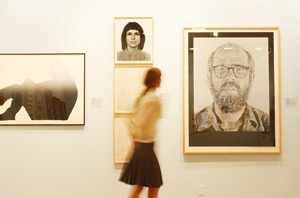An evocative slur of terms greets the museum-goer at the “”Portrait in America”” exhibition at the UA Museum of Art. Lists of cultural institutions, methods of portraiture and physical features snake around the upper portion of the exhibit.
Echoes of the cliché, “”a picture’s worth a thousand words”” spring to mind. Why would the museum choose to feature these words when so many expressive images should speak for themselves?
The effect is much like that of the quintessential American homestead wallpaper border giving kitchens and living rooms a framework to work within. With so many genres and styles of portraits in the exhibit, it’s easy to get lost in the variety. Words like “”gender,”” “”womanhood,”” “”otherness”” and “”selfhood”” give the exhibition shape and depth, reminding the audience they are more than painted faces.
Not to say the faces themselves aren’t impressive in their own right, when they are present. But they are not always present. The liberties taken with portraiture are rarely made as apparent as in “”Portrait in America.”” Some of the pieces are only recognizable as portraits because of titles like “”Self Portrait.””
Some are mere sketches, movement put to paper, as opposed to a careful study of the human form. Others are more traditional sit-down portraits, like William Sidney Mount’s “”Portrait of a Woman,”” dated 1832. One of the most striking works is Allison Saar’s “”Sleeping Beauty,”” a full-length work of woodcut on paper detailing a nude female form with vibrant orange.
Instead of following a chronological arrangement, the portraits are clustered into narrow categories, including the self-portrait and the commissioned portrait. This grouping alludes to another cliché: the melting pot that is all things American.









